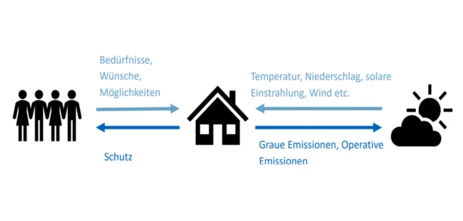Climate Culture Building
Climate- and Culture-Responsive Building in Building Physics
Efficient, sustainable, and socially embedded buildings arise from a balanced interplay of tradition and innovation. Many of today’s new buildings in Germany and Europe achieve a high standard in building physics thanks to stricter norms and regulations, requiring minimal energy for conditioning indoor climates. However, in practice, the climatic and cultural particularities of regional contexts are often insufficiently considered. Instead of differentiated solutions, standardized thresholds dominate, leading to a homogenized view of entire regions in terms of climate and culture.
Planning errors—such as large glass facades on sun-exposed building sides, unsuitable materials, or the neglect of cultural aspects like typical ventilation habits—can significantly compromise a building's energy efficiency and negatively impact its environmental footprint. Given that approximately 30% of global annual CO₂ emissions are attributed to the building sector, a holistic approach to building design and execution is essential.
In densely built urban areas in particular, a building does not only affect itself but also significantly influences its immediate surroundings. Facade materials, building height, geometry, and orientation impact lighting conditions, shading, air circulation, and even the thermal comfort of adjacent structures. Equally important is the precise placement of a building within an urban context in order to foster microclimates that are compatible with the urban climate and avoid negative synergy effects.
A central focus of our research is the integration of traditional, often passive building techniques—such as natural shading, cross-ventilation, or thermal mass—into contemporary architecture. These concepts not only contribute to energy savings and a reduction of technical interventions but also enhance the well-being of building users. Additionally, culturally appropriate architecture fosters social acceptance within the neighborhood and promotes a positive identification with the built environment.
Our research focus is dedicated to the systematic analysis of context-dependent parameters to enable climate- and culture-responsive building on a sound basis—both for new construction and the modernization of existing buildings. Among other things, we examine:
- Climatic and environmental conditions: solar path, temperature development, humidity, wind patterns, air quality, effects of climate change
- Resource availability: use of local building materials, transport logistics, environmental costs (LCA)
- Traditional construction methods: regionally proven, often passive architectural solutions
- Cultural living habits: usage patterns, aesthetic preferences, social structures
- Socioeconomic factors: standard of living, requirements for residential quality, values
- Building surroundings and framework conditions: urban vs. rural context, legal building regulations, building typology
The goal of our work is to foster a deeper understanding of the complex interrelationships between building physics, culture, and climate in every context. Based on this understanding, we develop future-oriented, resilient, and human-centered building approaches that are rooted in scientific knowledge while remaining locally grounded.
